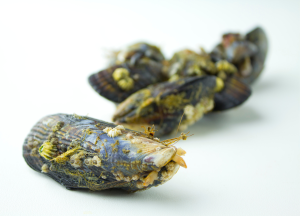Fresh Mussels With Reduced White Wine Sauce
The full ingredients and instructions are at the end of this post. You can scroll or jump down. Fair warning, if you do so… Well, let’s just say you’ll need a sleeping bag next to your favourite toilet for the night of the preparation. Might as well pitch a tent, cause you’ll miss out on the “how not to get poisoned by rotten mussels” part of the recipe.
Mussels, the poor man’s clam. Nasty, full of grimy “ear hair” from the deep, nothing more than cheap barnacle — and, yet, so freaking delicious. There are about 17 different species of edible mussels in the world. As a species, we’ve been bashing them open like chimps since in-memorable times. Find a mussel, splatter a mussel, slurp the mussel, pray to the Black Monolith, wonder where all the sinister chanting is coming from?, go take a nap, rinse and repeat. That was the norm for centuries. Mussels were just there, you could dip your hand in any pond or body of water and come up with a fistful of the little suckers.
Mussels’ Culinary Cues
In the USA, mussels became a culinary darling during the Second World War. Up until that point, the oblong molluscs were frown upon in dining halls. Gatsby fans liked oysters and clams, not dingy mussels. What changed? Wartime rationing. Beef, pork, chicken, fish and all the fine things those Michelin Star establishments made a pretty racket out of were being shipped overseas to aid the US military’s war effort. Mussels became the main substitute for most meats, and chefs had no other choice but to get creative with them. It was during this time when most recipes started popping up — they had no other choice but to get innovative with the mollusc.
Preparing your mussels
The most commonly eaten species of mussels, the one you’re likely to find or come across in your supermarket or fishmonger of choice is Mytilus edulis also known as the Blue Mussel. This invertebrate is the one that’s most sold, due to its ability to adapt and procreate like bunnies on Viagra, in aquaculture. They are the staple of most mussel-based cuisines outside of coastal regions.
It doesn’t matter what mussel recipe you’re going to dip your toes in, the most important step is preparing them. You might mess up the ingredients, make a pig’s breakfast out of the process and come out the other end with a dish that just doesn’t cut it —worse thing in that scenario, you just didn’t like the outcome. BUT if you skip the preparation process, and willy-nilly start cooking with your mussels right out of the gate, there’s a good chance you’ll end up with a bad case of backdoor jitters — that’s code for food poisoning.
Why do we need to prepare the mussels?
Simply put, because when we say they need to be fresh that’s also code — what we’re preaching is that they need to be alive. The first step, preparation, is needed in order to divide the dead mussels from the live ones.
- Grab your mussels out of the fridge and toss them in a bowl.
- Fill the bowl with water and ice cubes. Leave the mussels in this frigid bath for 2-3 hours. During this time they’ll start to move – open and close – and during the process filter out sand and other stuff they still have trapped within their shells.
- Remove mussels from the bowl. Conserve only those that are closed. Any open mussels are dead — toss those out.
- Clean your mussels with a steel wool sponge or a toothbrush.
Mussels in White Wine Sauce
Prep-Time 15 minutes.
Ingredients:
- 1 kg of clean fresh mussels.
- 3 tbsp of butter.
- 1/4 cup of onions or shallots.
- 1 1/4 cups of dry white wine.
- 1/4 cup of fresh parsley
- Sea salt and pepper.
Other condiments, like thyme, parsley, bay leaves, are up to the chef’s discretion and taste. Go nuts and improvise.
Tools
- Cutting board.
- Sharp knife.
- Large Skillet.
Instructions
- Over medium heat melt the butter.
2. Sauté the onions or shallots until they are translucent and flimsy.
3. Add wine, condiments and move them around — let them mingle with the onions.
4. Turn up the heat and allow the mixture to boil.
5. Once boiling, reduce the heat to a nice simmer and let the wine burn off. Here is where the alcohol evaporates and you’re left with just the supple textures of the wine, and none of its “spirit”.
6. Add mussels to the mixture. Toss them about like the kick-ass chef you are — or if you’re afraid of making a mess, use a wooden spoon and stir them in. Cover the mussels up with the onions and sauce.
7. Cover the Skillet and let the whole concoction cook in its vapors for 4-5 minutes.
8. Take the mix out of the heat. Toss out all the shells that haven’t opened — those mussels were also dead before the whole cook-off began, they are no good and can end up intoxicating you.
Serve doused in the whine sauce and sprinkle with a bit of lemon and parsley.


